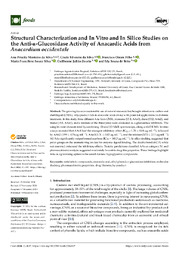Structural characterization and In Vitro and In Silico studies on the Anti-?-Glucosidase activity of Anacardic acids from Anacardium occidentale.
Structural characterization and In Vitro and In Silico studies on the Anti-?-Glucosidase activity of Anacardic acids from Anacardium occidentale.
Author(s): SILVA, A. P. M. DA; SILVA, G. S. DA; OIRAM FILHO, F.; SILVA, M. F. S.; ZOCOLO, G. J.; BRITO, E. S. de
Summary: The growing focus on sustainable use of natural resources has brought attention to cashew nut shell liquid (CNSL), a by-product rich in anacardic acids (AAs) with potential applications in diabetes treatment. In this study, three different AAs from CNSL, monoene (15:1, AAn1), diene (15:2, AAn2), and triene (15:3, AAn3), and a mixture of the three (mix) were evaluated as ?-glucosidase inhibitors. The samples were characterized by combining 1D and 2D NMR spectroscopy, along with ESI-MS. In vitro assays revealed that AAn1 had the strongest inhibitory effect (IC50 = 1.78 ± 0.08 ?g mL?1), followed by AAn2 (1.99 ± 0.76 ?g mL?1), AAn3 (3.31 ± 0.03 ?g mL?1), and the mixture (3.72 ± 2.11 ?g mL?1). All AAs significantly outperformed acarbose (IC50 = 169.3 ?g mL?1). In silico docking suggested that polar groups on the aromatic ring are key for enzyme–ligand binding. The double bond at C15, while not essential, enhanced the inhibitory effects. Toxicity predictions classified AAs as category IV, and pharmacokinetic analysis suggested moderately favorable drug-like properties. These findings highlight AAs as a promising option in the search for new hypoglycemic compounds.
Publication year: 2024
Types of publication: Journal article
Observation
Some of Embrapa's publications are published as ePub files. To read them, use or download one of the following free software options to your computer or mobile device. Android: Google Play Books; IOS: iBooks; Windows and Linux: Calibre.
Access other publications
Access the Agricultural Research Database (BDPA) to consult Embrapa's full library collection and records.
Visit Embrapa Bookstore to purchase books and other publications sold by Embrapa.

